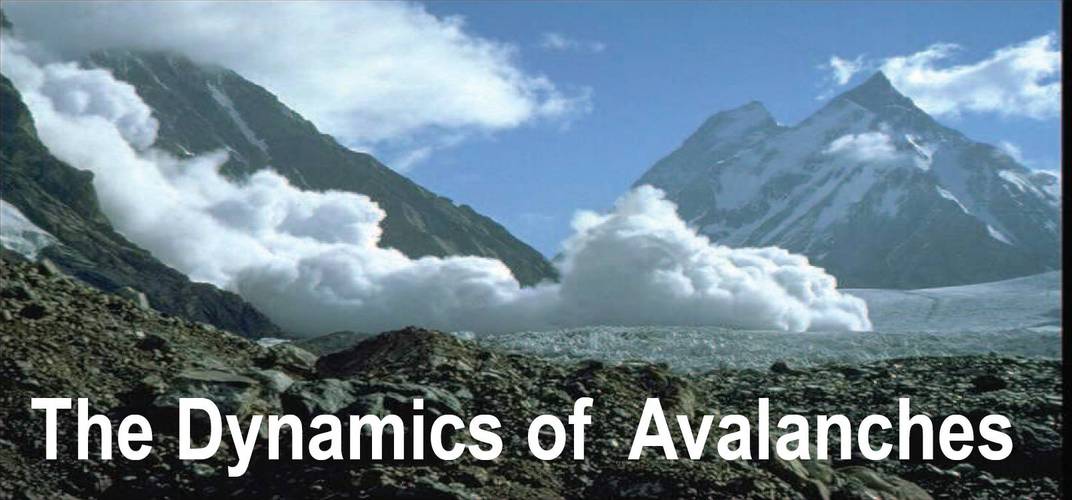An avalanche, however, is a physical phenomenon, and as such it should
manifest certain universal characteristics. For instance, avalanches of
carbon dioxide ice have been seen on the surface of Mars.
This talk will describe one mathematician's efforts to understand snow
avalanches. The work ranges from investigating avalanche disasters in
the Japanese mountains to dropping half a million ping-pong balls down
a ski jump.


More than a million avalanches happen throughout the world every year.
Most fall harmlessly, but the largest can destroy whole towns and kill
thousands. In Western Europe, such large disasters are rare, but even
so, in any given year, dozens of skiers, snowboarders and climbers may
be killed, and in a bad year it can be hundreds.
Jim McElwaine's research is in geophysical fluid dynamics, with a
focus on granular and multi-component flows. At the University of
Cambridge, he received a PhD in Applied Mathematics studying quantum
mechanics and its interpretation. After positions in Japan, Europe, and
the United States, he became Professor of Geohazards in the Department
of Earth Sciences at the University of Durham. His work ranges widely
over many geophysical flows as well as fundamental problems in granular
and fluid mechanics. He is also a senior scientist at the Planetary
Science Institute in Tucson, where he researches surface processes on
other planets and asteroids. A keen climber and skier, McElwaine's love
affair with avalanches began after he was hit and buried by a large one
on an unclimbed mountain in the Himalayas. Nowadays, he is more careful
-- being buried up to his waist is more typical.
Play Flash full motion video, or Flash lower bandwidth video.
 (Or, right-click to download the 3gp file.)
(Or, right-click to download the 3gp file.)
Play QuickTime full motion movie
[ or Stream |
or Download ]
Or play QuickTime lower bandwidth slideshow
[ or Download ]
Or [ Download the Podcast ].

Begin streaming RealMedia.
(Or, right-click to download the audio file.)

To begin viewing slides, click on the first slide below. (Or, view as pdf.)
![[01]](tn/01.jpg)
![[02]](tn/02.jpg)
![[03]](tn/03.jpg)
![[04]](tn/04.jpg)
![[05]](tn/05.jpg)
![[06]](tn/06.jpg)
![[07]](tn/07.jpg)
![[08]](tn/08.jpg)
![[09]](tn/09.jpg)
![[10]](tn/10.jpg)
![[11]](tn/11.jpg)
![[12]](tn/12.jpg)
![[13]](tn/13.jpg)
![[14]](tn/14.jpg)
![[15]](tn/15.jpg)
![[16]](tn/16.jpg)
![[17]](tn/17.jpg)
![[18]](tn/18.jpg)
![[19]](tn/19.jpg)
![[20]](tn/20.jpg)
![[21]](tn/21.jpg)
![[22]](tn/22.jpg)
![[23]](tn/23.jpg)
![[24]](tn/24.jpg)
![[25]](tn/25.jpg)
![[26]](tn/26.jpg)
![[27]](tn/27.jpg)
![[28]](tn/28.jpg)
![[29]](tn/29.jpg)
![[30]](tn/30.jpg)
![[31]](tn/31.jpg)
![[32]](tn/32.jpg)
![[33]](tn/33.jpg)
![[34]](tn/34.jpg)
![[35]](tn/35.jpg)
![[36]](tn/36.jpg)
![[37]](tn/37.jpg)
![[38]](tn/38.jpg)
![[39]](tn/39.jpg)
![[40]](tn/40.jpg)
![[41]](tn/41.jpg)
![[42]](tn/42.jpg)
![[43]](tn/43.jpg)
![[44]](tn/44.jpg)
![[45]](tn/45.jpg)
![[46]](tn/46.jpg)
![[47]](tn/47.jpg)
![[48]](tn/48.jpg)
![[49]](tn/49.jpg)
![[50]](tn/50.jpg)
![[51]](tn/51.jpg)
![[52]](tn/52.jpg)
![[53]](tn/53.jpg)
![[54]](tn/54.jpg)
![[55]](tn/55.jpg)
![[56]](tn/56.jpg)
![[57]](tn/57.jpg)
![[58]](tn/58.jpg)
![[59]](tn/59.jpg)
![[60]](tn/60.jpg)